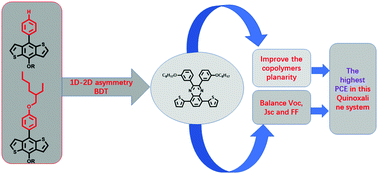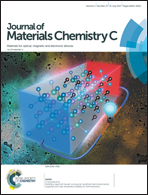Asymmetric 2D benzodithiophene and quinoxaline copolymer for photovoltaic applications
Abstract
Two novel copolymer donors based on one-dimensional (1D)–two-dimensional (2D) asymmetrical benzodithiophene (BDT) units (BDTPH-H and BDTPH-OR) and 2,3-diphenyl-5,8-di(thiophen-2-yl)quinoxaline (DTQx) were synthesized and compared with one-dimensional or two-dimensional symmetric BDT unit based photovoltaic polymers. Both asymmetrical polymers exhibited promising photovoltaic performance compared with 1D and 2D symmetric BDT polymers. The power conversion efficiency (PCE) of PBDTPH-DTQx based polymer solar cells is 5.6%, with balanced VOC = 0.7 V, JSC = 11.89 mA cm−2 and FF = 67.3%, which is almost the highest PCE compared with similar BDT unit and fluorine-free substituted DTQx based polymer. What is more, PBDTPH-DTQx shows better performance than PBDTPHO-DTQx due to the single phenyl making DTQx more planar and with better π–π stacking than alkoxy phenyl. These findings demonstrate that the 1D–2D asymmetrical BDT units are also applicable to poor planarity fluorine-free substituted quinoxaline acceptor system.



 Please wait while we load your content...
Please wait while we load your content...